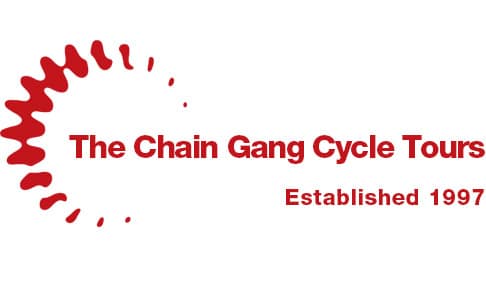Why? The start point was our new tour of Languedoc. Our old Provence tour spent a couple of days in Languedoc, mostly to visit the Pont du Gard. Now we have a Languedoc tour that explores Languedoc, and a Provence tour that explores Provence.

And here’s a great reason, that people have already asked me about on Facebook. Cycling into Avignon isn’t necessarily a pleasant experience, especially from the East on a Friday afternoon. No more! Round of applause.
All the details of the new tour are on our website, but I’d like to choose just three of the highlights and introduce them to you.
1. The Abbey of Sénanque.

Founded in 1148, the abbey follows the template of other Cistercian abbeys. It’s in a beautiful, remote setting; it’s still a working abbey, based on the Cistercian principles of manual labour and self-sufficiency, and today the monks earn their living by growing lavender and producing honey.
It’s a beautiful place (although tours of the abbey are limited), and it’s in a beautiful setting. It’s inside the Lubéron National Park, about 3 miles from Gordes (itself a beautiful village where we’ll spend a bit of time). It’s a decent climb out of Gordes, on tine back roads with beautiful views until we see the Abbey in the valley formed by the river Sénancole.
You can read more about this beautiful abbey here, and if you click on any of the images here you’ll see enlarged photographs courtesy of the Office de Tourisme of Vaucluse. Or book a Provence tour with us and come and have a closer look!
2. The Wines of Provence.

This is a vast area, stretching from the massif central to the Lubéron hills, and for 200 Km up the River Rhône from Avignon. They produce over 400 million bottles a year, including AOC Tavel, popularly acclaimed as the finest rosé wine in France, Chateauneuf du Pape, which comes in both red and white (but rosé is not allowed), and a huge variety of Crus, Villages and Côtes du Rhône wines
As you can imagine, the rules vary enormously, which grapes you can use, which grapes you can’t. How much grenache you can use, how much syrah (shiraz) you must use. And in some cases what % of your harvest you have to throw away!
In the past these wines have been a bit incidental to our tour. It’s time that was changed. Any book you read about Provence will feature these wines, so we’ll have a good go at introducing you and the wines to each other.
3. Olives.

 This really is long, long overdue. Olive groves are everywhere in Provence, and the oil is a very important part of the cuisine, culture and economy of the region.
This really is long, long overdue. Olive groves are everywhere in Provence, and the oil is a very important part of the cuisine, culture and economy of the region.
Ninety per cent of the olive trees in the world are found around the mediterranean. France ranks only 12th in world terms for olive production, with 3.5 million trees. This is down from 26 million trees in the 19th century, mostly because of the catastrophic freeze of 1956 which also wiped out so many of France’s vines.
Most of French olive production (70%) is centred in Provence, and Provençale olive oil is considered among the highest quality in the world.

They are a complicated crop. And we’re going to find out more about them when we visit the olive groves of Domaine Plaines Marguerite.
Even if you’ve cycled with us in Provence, have a look at this new tour. Join us again!


